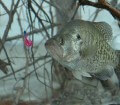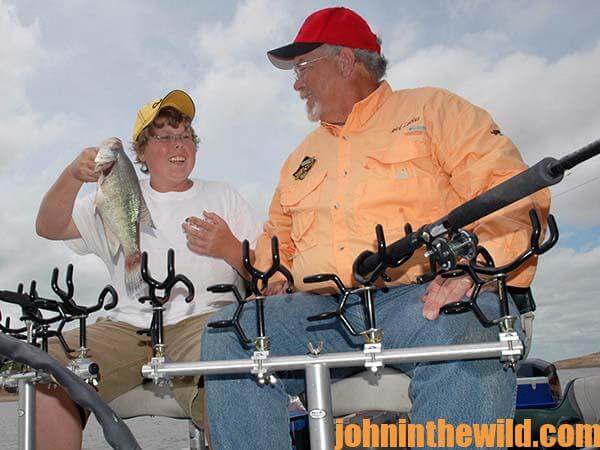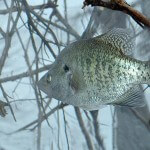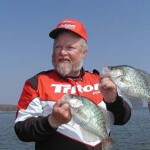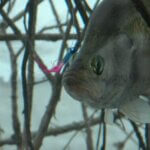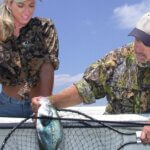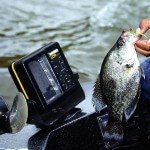John’s Note: 2014 is Steve McCadams’ 40th year of guiding crappie fishermen on Kentucky Lake. He also fished crappie tournaments for 10 years, and at one time he was part owner of Crappie USA. “I guess you could call me a crappie farmer, because I put out a lot of crappie cover and harvest a lot of crappie,” McCadams says. Except when he’s guiding or hunting ducks, McCadams guides crappie fishermen and catches crappie every day of the year. The secret for finding and catching crappie is to know where the crappie live and build homes for crappie. “I guide for crappie 9-10 months out of the year on Kentucky Lake, and we’ve never struck out,” McCadams reports. He only may catch 1-10 crappie, when he’s fishing an hour or two on the lake, because of high winds, snow, thunder or lightning. With two clients in the boat, McCadams averages keeping 40-45 crappie per day. On Kentucky Lake where he primarily fishes, anglers only can keep crappie 10-inches long or longer. However, on an average day, his clients may catch 100 crappie and release the undersized ones.
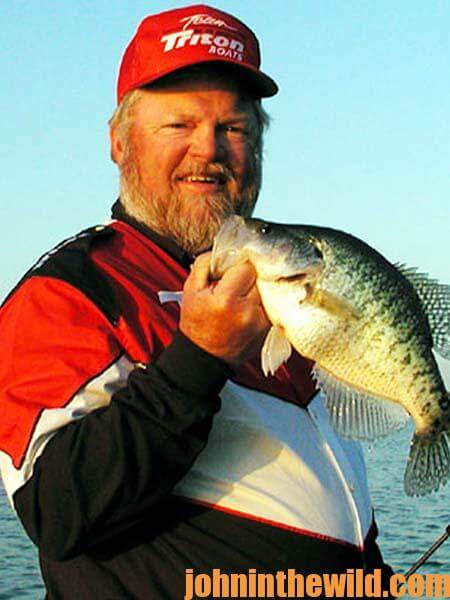 An ongoing debate that never will be totally resolved about shiner minnows is that some anglers believe that big crappie like big shiners.
An ongoing debate that never will be totally resolved about shiner minnows is that some anglers believe that big crappie like big shiners.
Other anglers are convinced that big crappie like little shiners better. Refusing to argue, the middle-of-the-roaders will opt for medium sized shiners. I fish with a fairly large shiner, and my favorite is the emerald shiner. Here on Kentucky Lake we’re fortunate to catch some pretty-big crappie. Often, I’ve found that the big crappie seem to prefer a bigger minnow.
Because we have a 10 inch size limit here on Kentucky Lake, we have to let our crappie grow to bigger sizes than the lakes without a 10-inch limit. So, when we’re fishing live minnows, I prefer a 2- to a 2-1/2-inch medium-to-large minnow. When I’m fishing in really deep water with a double-hook crappie rig, I like a bigger minnow. I believe the bigger minnows live longer in deep water than the smaller minnows do.
I consider deep water to be 16-feet deep or deeper.
The deepest I’ve ever caught crappie here on Kentucky Lake was 25- to 28-feet deep. The crappie often will go that deep in late winter – from the end of February until the first week or two of March. Many people think that crappie go to their deepest depths to hold during the hot summer months, but that hasn’t been my experience here. On Kentucky Lake, the crappie seem to be in the deepest water in late winter. I fish in water depths of 20- to 25-feet deep much of the time. I know that most crappie fishermen rarely if ever fish in those water depths.
I’m often asked “What’s the biggest crappie you or your fishermen ever have caught on Kentucky Lake?” 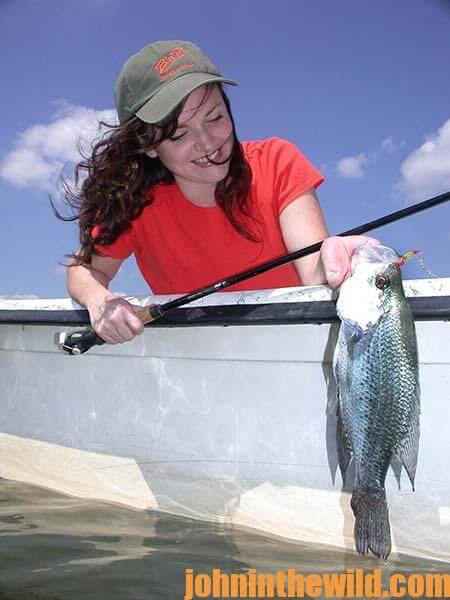 We’ve had a few crappie that have weighed 3 pounds or more over the years. And, we’ve caught numbers of crappie weighing 2 pounds or more. The average crappie that we catch day in and day out will weigh about 3/4-pound. Our limit at this writing on crappie on Kentucky Lake is 30 crappie per person, 10-inches or longer. Usually in a day of fishing with two anglers, we’ll catch some 2-pound crappie, but not every day.
We’ve had a few crappie that have weighed 3 pounds or more over the years. And, we’ve caught numbers of crappie weighing 2 pounds or more. The average crappie that we catch day in and day out will weigh about 3/4-pound. Our limit at this writing on crappie on Kentucky Lake is 30 crappie per person, 10-inches or longer. Usually in a day of fishing with two anglers, we’ll catch some 2-pound crappie, but not every day.
One of the things I’ve learned is there are plenty of good crappie to be caught after the spawn, especially during the month of June.
At this time of the year, most of the crappie we catch will be caught in water depths of 12- to14-feet deep, which I call the mid-range depth zone. After the spawn, the crappie will pull up and hold in this water depth for about 6 weeks. At this time of the year, many crappie fishermen already have rolled-up their poles and are sitting at home in the air conditioning.
Another advantage to fishing that 6 weeks of summer is that our section of the country usually has stable weather.
We also have stable lake levels at this time of the year.
The second half of July and even into August, I still can catch a few crappie in that water depth. But when the weather gets really, really hot and stays hot, we move out to 18- to 20-foot water depth. Usually, we’ll be fishing on the edges of underwater creek channels and underwater ledges. I’ll have stake beds and brush shelters in those water depths, but I also fish natural cover that’s still left in the lake.
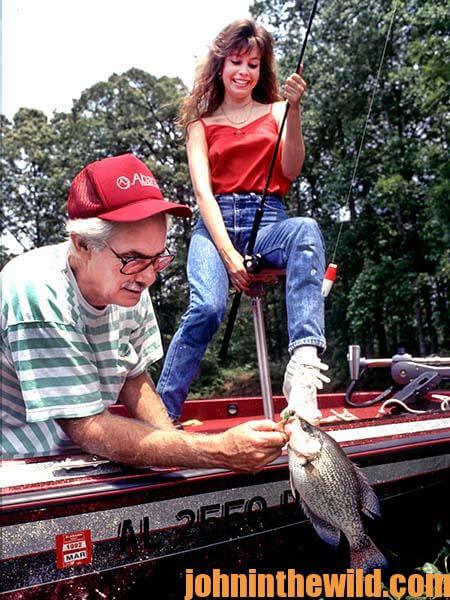 I prefer a hand-held Garmin GPS to find and locate my deep-water fishing spots, but I still use triangulation and landmarks to find and fish much of my deep-water structure, because that’s the system I’ve used all my life. Today I primarily use my landmark and triangulation system more often to help me get close to the spots I want to fish. Then I use my hand-held GPS to put me exactly on those deep-water crappie hide-outs. I really believe the hand-held GPS receiver saves the crappie fisherman a lot of time and makes him more efficient, when locating drop-offs, ledges, creek channels and brush shelters.
I prefer a hand-held Garmin GPS to find and locate my deep-water fishing spots, but I still use triangulation and landmarks to find and fish much of my deep-water structure, because that’s the system I’ve used all my life. Today I primarily use my landmark and triangulation system more often to help me get close to the spots I want to fish. Then I use my hand-held GPS to put me exactly on those deep-water crappie hide-outs. I really believe the hand-held GPS receiver saves the crappie fisherman a lot of time and makes him more efficient, when locating drop-offs, ledges, creek channels and brush shelters.
Anglers often ask me, “Steve, do you know the type cover, stake beds or structure that you’re fishing every time you pull up to a spot and let your baits down to that spot?” My answer is, “Yes, I do.” As I’ve mentioned before, I’m a crappie farmer at Kentucky Lake. I know where I’ve planted every crappie attractor that I’ve put into the lake over the last 40 years. I almost can remember the day that I’ve sunk a pallet, driven stakes into the bottom, and/or sunk a treetop.
To learn more about fishing with Steve McCadams and fishing Kentucky Lake you can go to his website www.stevemccadams.com, or call 731-642-0360.
To learn much more about crappie fishing, get John E. Phillips’ Kindle eBooks and some print books, “Crappie: How to Catch Them Fall & Winter,” “Crappie: How to Catch Them Spring and Summer,” “Catch Cold Water Crappie Now,” and “Reelfoot Lake: How to Fish for Crappie, Bass, Bluegills and Catfish & Hunt for Ducks.” Click here to get these books.
Share this page with a friend!
About the Author
John Phillips, winner of the 2012 Homer Circle Fishing Award for outstanding fishing writer by the American Sportfishing Association (ASA) and the Professional Outdoor Media Association (POMA), the 2008 Crossbow Communicator of the year and the 2007 Legendary Communicator chosen for induction into the National Fresh Water Hall of Fame, is a freelance writer (over 6,000 magazine articles for about 100 magazines and several thousand newspaper columns published), magazine editor, photographer for print media as well as industry catalogues (over 25,000 photos published), lecturer, outdoor consultant, marketing consultant, book author and daily internet content provider with an overview of the outdoors.

